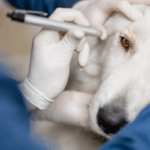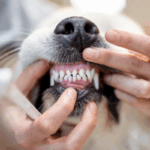As summer comes closer, it means trips to the beach, the lake or river. For our furry canine friends, this means endless hours of fun and swimming. With Blackburn Lake not too far from our clinic, we tend to see many ear infections caused by a harmless drip in the lake to cool down.
Why does my dog get ear infections?
Normal ear canals in dogs are not sterile with small numbers of bacteria and year present.
In a normal ear, the wax does not accumulate due to ‘self cleaning’ where the skin grows out from the ear drum, acting like a conveyor belt carrying out the debris.
Infections in all ears ultimately happen because there has been a change in the normal climate of the ear, encouraging the overgrowth of bugs.
Dogs with ear infections are miserable. Their ears are a source of constant pain resulting in head shaking and scratching. However, that is not the only problem. Head shaking and scratching can also cause broken blood vessels in the ear flap, which can require surgery. Chronic ear infections can penetrate the ear drum and result in an internal ear infection.
Some reasons include:
- Skin allergies
- Foreign bodies eg. grass seeds
- Ear mites
- Damage / trauma to the ear drum
- Water contamination (from swimming or a simple bath)
How are ear infections treated?
The result of an otoscopic examination, along with careful scanning of a sample from the ear under the microscope will determine if any treatment is needed.
It can be as simple as taking home some ear drops. Although, some dogs can have quite a heavy build up which will require some sedation or an anaesthetic so we can clean the ear canal completely.
COMMONLY ASKED QUESTIONS
Since these symptoms are similar and usually mean an infection, can I not just collect some medication?
There are several kinds of bacteria and at least one type of fungus which might cause an ear infection. Without knowing the kind of infection present, we do not know which medication to use.
In some cases the ear infection may be caused by a foreign body or tumour in the ear canal. Treatment with medication alone will not resolve these problems.
Your pet must also be examined to be sure that the eardrum is in tact. Administration of certain medications can result in the loss of hearing if the eardrum is ruptured.
What is the prognosis?
Most ear infections that are properly diagnosed and treated can be cured. However, if an underlying cause remains unidentified and untreated, the outcome will be less favourable. Several examinations may be needed before the process is complete and we can expect ultimate success.
Administering medication
It is important to get the mediation into the horizontal ear canal. Be aware that the dogs external ear canal is ‘L’ shaped. The vertical canal connects with the outside of the ear, the horizontal canal lies deeper and terminates at the eardrum.
The ear canal may be medication by following these steps:
- Gently pull the ear flap straight up and hold it with one hand.
- Apply a small amount of medication into the vertical part of the ear canal while continuing to keep the ear flap elevated.
- Put one finger in front of and at the base of the ear flap, and put your thumb behind it at the base.
- Gently massage the ear canal between your finger and thumb. DO NOT ‘milk’ the canal contents towards the ear drum as it may be damaged by doing so. A swishing sounds tells you that the mediation has gone into the horizontal canal.
- Release the ear and let your dog shake its head. If the medication contains a wax solvent, debris will be dissolved so it can be shaken out.
- If a second medication is to be used, apply it in the same manner.
- You can clean out the ‘outer’ part of the canal / inside of the ear flap with a tissue. DO NOT use cotton tips as they tend to push debris back into the vertical ear canal.






